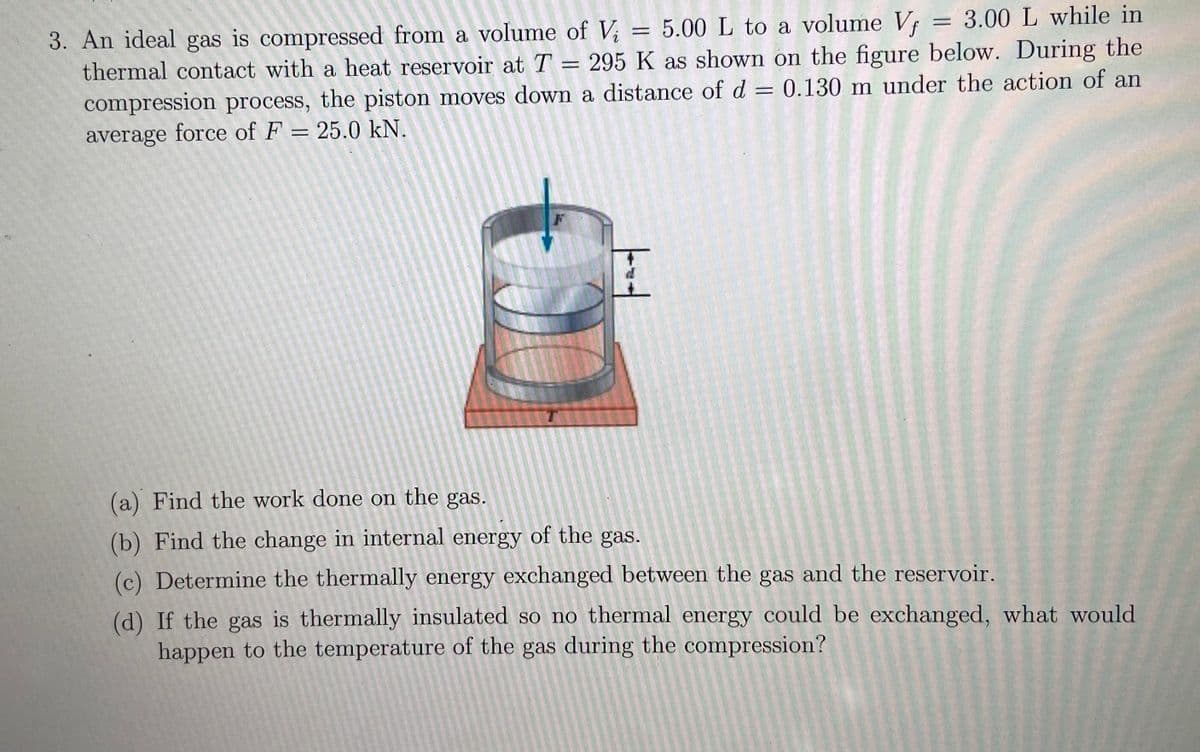3. An ideal gas is compressed from a volume of V, = 5.00 L to a volume Vf thermal contact with a heat reservoir at T = 295 K as shown on the figure below. During the compression process, the piston moves down a distance of d = 0.130 m under the action of an average force of F = 25.0 kN. = 3.00 L while in (a) Find the work done on the gas. (b) Find the change in internal energy of the gas. (c) Determine the thermally energy exchanged between the gas and the reservoir. (d) If the gas is thermally insulated so no thermal energy could be exchanged, what would happen to the temperature of the gas during the compression?
3. An ideal gas is compressed from a volume of V, = 5.00 L to a volume Vf thermal contact with a heat reservoir at T = 295 K as shown on the figure below. During the compression process, the piston moves down a distance of d = 0.130 m under the action of an average force of F = 25.0 kN. = 3.00 L while in (a) Find the work done on the gas. (b) Find the change in internal energy of the gas. (c) Determine the thermally energy exchanged between the gas and the reservoir. (d) If the gas is thermally insulated so no thermal energy could be exchanged, what would happen to the temperature of the gas during the compression?
Physics for Scientists and Engineers, Technology Update (No access codes included)
9th Edition
ISBN:9781305116399
Author:Raymond A. Serway, John W. Jewett
Publisher:Raymond A. Serway, John W. Jewett
Chapter20: The First Law Of Thermodynamics
Section: Chapter Questions
Problem 20.12OQ: If a gas is compressed isothermally, which of the following statements is true? (a) Energy is...
Related questions
Question

Transcribed Image Text:3. An ideal gas is compressed from a volume of V;
thermal contact with a heat reservoir at T = 295 K as shown on the figure below. During the
compression process, the piston moves down a distance of d = 0.130 m under the action of an
average force of F = 25.0 kN.
5.00 L to a volume V = 3.00 L while in
F
(a) Find the work done on the gas.
(b) Find the change in internal energy of the gas.
(c) Determine the thermally energy exchanged between the gas and the reservoir.
(d) If the gas is thermally insulated so no thermal energy could be exchanged, what would
happen to the temperature of the gas during the compression?
Fal
Expert Solution
This question has been solved!
Explore an expertly crafted, step-by-step solution for a thorough understanding of key concepts.
This is a popular solution!
Trending now
This is a popular solution!
Step by step
Solved in 2 steps

Recommended textbooks for you

Physics for Scientists and Engineers, Technology …
Physics
ISBN:
9781305116399
Author:
Raymond A. Serway, John W. Jewett
Publisher:
Cengage Learning

Principles of Physics: A Calculus-Based Text
Physics
ISBN:
9781133104261
Author:
Raymond A. Serway, John W. Jewett
Publisher:
Cengage Learning


Physics for Scientists and Engineers, Technology …
Physics
ISBN:
9781305116399
Author:
Raymond A. Serway, John W. Jewett
Publisher:
Cengage Learning

Principles of Physics: A Calculus-Based Text
Physics
ISBN:
9781133104261
Author:
Raymond A. Serway, John W. Jewett
Publisher:
Cengage Learning


Physics for Scientists and Engineers with Modern …
Physics
ISBN:
9781337553292
Author:
Raymond A. Serway, John W. Jewett
Publisher:
Cengage Learning

Physics for Scientists and Engineers
Physics
ISBN:
9781337553278
Author:
Raymond A. Serway, John W. Jewett
Publisher:
Cengage Learning

College Physics
Physics
ISBN:
9781285737027
Author:
Raymond A. Serway, Chris Vuille
Publisher:
Cengage Learning